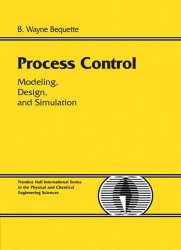Engineering Bookshelf
- Aerospace
- Biological
- Civil
- Chemical
- Environmental
- Electrical
- Materials
- Mechanical
- Petroleum
- Geoengineering
- Software

Process Control: Modeling, Design and Simulation
by B. Wayne BequettePublisher: Prentice Hall
ISBN: 0133536408
Check price @ amazon.com , amazon.ca , amazon.co.uk
Book Description
This is the first complete introduction to process control that fully integrates software tools enabling professionals and students to master critical techniques hands on, through computer simulations based on the popular MATLAB environment. Process Control: Modeling, Design, and Simulation teaches the field's most important techniques, behaviors, and control problems through practical examples, supplemented by extensive exercises, with detailed derivations, relevant software files, and additional techniques available on a companion Web site.
Master process control hands on, through practical examples and MATLAB® simulations
Coverage includes:
- Fundamentals of process control and instrumentation, including objectives, variables, and block diagrams
- Methodologies for developing dynamic models of chemical processes
- Dynamic behavior of linear systems: state space models, transfer function-based
- models, and more
- Feedback control; proportional, integral, and derivative (PID) controllers; and closed-loop stability analysis
- Frequency response analysis techniques for evaluating the robustness of control systems
- Improving control loop performance: internal model control (IMC), automatic tuning, gain scheduling, and enhancements to improve disturbance rejection
- Split-range, selective, and override strategies for switching among inputs or outputs
- Control loop interactions and multivariable controllers
- An introduction to model predictive control (MPC)
Bequette walks step by step through the development of control instrumentation diagrams for an entire chemical process, reviewing common control strategies for individual unit operations, then discussing strategies for integrated systems. The book also includes 16 learning modules demonstrating how to use MATLAB and SIMULINK to solve several key control problems, ranging from robustness analyses to biochemical reactors, biomedical problems to multivariable control.
About the Author
B. WAYNE BEQUETTE is Professor of Chemical Engineering at Rensselaer Polytechnic Institute. His teaching and research interests are in the areas of process systems and control engineering for biomedical systems, pharmaceuticals, chromatography, and complex chemical processes. He is Associate Editor of Automatica, a journal of the International Federation of Automatic Control, and General Chair for the 2003 American Control Conference. He is the author of Process Dynamics: Modeling, Analysis, and Simulation (Prentice Hall).
Customer Reviews
By David De Sousa
This book successfully teaches how to analyze dynamic chemical processes and develop automatic control strategies to operate them safely and economically. Rather than simply present theory topics and develop analytical solutions, this textbook uses "interactive learning" through computer-based simulation exercises, employing for this the very popular "Matlab" engineering software package, and the "Simulink" block-diagram simulation environment. Introductions to both "Matlab" and "Simulink" are included in the book.
Each chapter of the book is followed by a series of "learning modules" that serve several purposes: some focus on software tools, while others focus on particular control problems.
An introduction to process control and instrumentation is presented in chapter 1. The development and use of models is very important in control systems engineering, and fundamentals models are developed in chapter 2, including the steady-state solution and linearization to form steady-state models. Chapter 3 focuses on the dynamic behavior of linear systems, starting with state space models and then covering transfer function-based models in detail. Chapter 4 covers the development of empirical models, including continuous and discrete transfer function models.
Chapter 5 provides a detailed introduction to feedback control, developing the basics of feedback systems, PID controllers, and methods of analyzing closed-loop stability. Chapter 6 presents methods for controller tuning. Frequency response analysis techniques, important for determining control system robustness, are presented in chapter 7.
Model-based control leads to improved control loop performance, and one of the clearest model-based techniques (Internal Model Control o IMC) is presented in chapter 8...
By Jon Anderson
I chose this item because it was required for my class and ended up reading a fair amount but the book skips many important steps and asks questions on things it never covered. Ideally, there would also be the answers in the back to double check my work but that was overlooked unfortunately.
Overall, I wouldn't actually choose this book to learn process control if I wasn't in a class that required it.